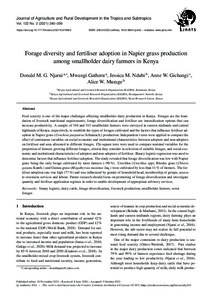Forage diversity and fertiliser adoption in Napier grass production among smallholder dairy farmers in Kenya
| dc.date.accessioned | 2021-11-12T12:08:22Z | |
| dc.date.available | 2021-11-12T12:08:22Z | |
| dc.date.issued | 2021-11-10 | |
| dc.identifier | doi:10.17170/kobra-202110274962 | |
| dc.identifier.uri | http://hdl.handle.net/123456789/13381 | |
| dc.language.iso | eng | eng |
| dc.rights | Namensnennung 4.0 International | * |
| dc.rights.uri | http://creativecommons.org/licenses/by/4.0/ | * |
| dc.subject | binary logistic | eng |
| dc.subject | dairy cattle | eng |
| dc.subject | forage diversification | eng |
| dc.subject | livestock production | eng |
| dc.subject | smallholder farmers | eng |
| dc.subject | sown forages | eng |
| dc.subject.ddc | 630 | |
| dc.title | Forage diversity and fertiliser adoption in Napier grass production among smallholder dairy farmers in Kenya | eng |
| dc.type | Aufsatz | |
| dcterms.abstract | Feed scarcity is one of the major challenges affecting smallholder dairy production in Kenya. Forages are the foundation of livestock nutritional requirements; forage diversification and fertiliser are intensification options that can increase productivity. A sample of 316 and 313 smallholder farmers were surveyed in eastern midlands and central highlands of Kenya, respectively, to establish the types of forages cultivated and the factors that influence fertiliser adoption in Napier grass (Cenchrus purpureus Schumach.) production. Independent t-tests were applied to compare the effect of continuous variables on social economic and institutional characteristics between adopters and non-adopters on fertiliser and area allocated to different forages. Chi-square tests were used to compare nominal variables for the proportion of farmers growing different forages, criteria they consider in selection of suitable forages, and social economic and institutional characteristics of adopters and non-adopters of fertiliser. Binary logistic regression was used to determine factors that influence fertiliser adoption. The study revealed that forage diversification was low with Napier grass being the only forage cultivated by most farmers (~90%). Urochloa (Urochloa spp), Rhodes grass (Chloris gayana Kunth.) and Guinea grass (Megathyrsus maximus Jaq.) were cultivated by less than 11% of farmers. The fertiliser adoption rate was high (77%) and was influenced by gender of household head, membership of groups, access to extension services and labour. Future research should focus on promoting of forage diversification and investigate quantity and fertiliser application regimes in order to enable development of appropriate advisory services. | eng |
| dcterms.accessRights | open access | |
| dcterms.creator | Njarui, Donald M. G. | |
| dcterms.creator | Gatheru, Mwangi | |
| dcterms.creator | Ndubi, Jessica M. | |
| dcterms.creator | Gichangi, Anne W. | |
| dcterms.creator | Murage, Alice Warukira | |
| dc.subject.swd | Kenia | ger |
| dc.subject.swd | Milchproduktion | ger |
| dc.subject.swd | Milchkuh | ger |
| dc.subject.swd | Futtermittel | ger |
| dc.subject.swd | Abwechslung | ger |
| dc.subject.swd | Nahrungsmangel | ger |
| dc.subject.swd | Viehwirtschaft | ger |
| dc.subject.swd | Kleinbauer | ger |
| dc.subject.swd | Futterbau | ger |
| dc.type.version | publishedVersion | |
| dcterms.source.identifier | eissn:2363-6033 | |
| dcterms.source.issue | No. 2 | |
| dcterms.source.journal | Journal of Agriculture and Rural Development in the Tropics and Subtropics (JARTS) | eng |
| dcterms.source.pageinfo | 245-256 | |
| dcterms.source.volume | Vol. 122 | |
| kup.iskup | false |
Dateien zu dieser Ressource
Das Dokument erscheint in:
-
Vol 122, No 2 (2021) [16]


